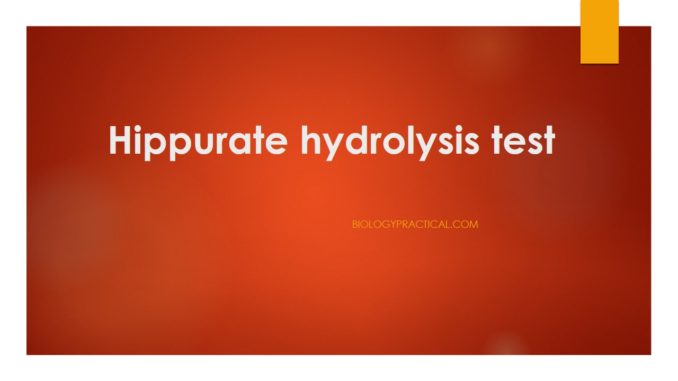
Principle of Hippurate hydrolysis test :
Hippurate hydrolysis test is performed for the identification of Campylobacter jejuni, Listeria monocytogenes, Gardnerella vaginalis, and Streptococcus agalactiae. The identification is carried out by detecting the ability of the organism to hydrolyse sodium hippurate to benzoic acid and glycine by the action of the enzyme hippuricase. Hippurate is the glycine conjugate of benzoic acid. In 48hr long classical method, the ability of bacteria spp to hydrolyse hippurate was tested by using ferric chloride indicator. Ferric chloride detected benzoic acid produced during hydrolysis. A 2 hr rapid technique has been developed which uses ninhydrin as indicator for the detection of glycine. Ninhydrin reacts with glycine forming a deep blue or purple colour.
Requirements:
- Sterile wooden sticks or inoculating loops
- Incubator at 35°C
- Test tubes
- Distilled water
- Ninhydrin
- Ferric chloride
Procedure of Hippurate hydrolysis test:
A. Classical Method:
- First prepare sterile Sodium Hippurate broth and inoculate with test organism.
- Incubate at 35°C for 8-24 hours
- Centrifuge the broth and remove the precipitate.
- Add Ferric chloride reagent in the supernatant.
- Observe for the precipitate and if the precipitate still remains after 10 minutes, it indicates presence of benzoic acid. Thus the test is positive for hippurate hydrolysis
B. Ninhydrin Method:
- Prepare a hippurate tube
- Add 0.2 ml of distilled water at a pH of 6.8 to 7.2 to reconstitute lyophilized tube test reagent.
- Add 2 drops of distilled water to an empty tube for disk or tablet tests.
- Defrost one 0.4 ml tube per test for prepared reagent.
- In the tube, make a heavy suspension from an 18 to 24 hr culture. Use care not to pick up agar, which contains protein.
- For disk or tablet tests, add reagent after inoculation of the tube with the culture.
- Incubate the tube for 2 h at 35 to 37°C.
- After the 2 hr incubation period, add 2 drops of the ninhydrin solution to the hippurate reagent-organism mixture.
- Add an additional 2 drops if test has 0.4 ml of hippurate.
- Re-incubate at 35 to 37°C for 30 min. Observe the tubes at 10-min intervals for the appearance of a deep blue colour, which is a positive test. The colour change will usually appear within 10 to 15 min after the ninhydrin indicator solution has been added.
Results interpretations:
- Positive result: The appearance of a deep blue colour within 30min is suggestive of positive reaction.
- Negative result: A faint purple colour or no change in colour indicates negative test.

Limitations:
- Other biochemical tests are recommended to confirm the identification.
- A small percentage of C. jejuni organisms are hippurate negative and must be identified by other methods.
- There are high chances of false positive results if incubation with ninhydrin exceeds 30min.
